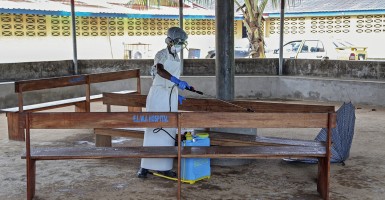This latest outbreak of the Ebola virus is getting a great deal of attention, as it should. Here are some questions that need to be asked and some answers you need to know:
What is Ebola?
The Ebola virus is a severe, often fatal disease that is in the hemorrhagic fever category. The symptoms include sudden onset of fever, intense weakness, muscle pain, headache and sore throat. This is followed by vomiting, diarrhea, rash, impaired kidney and liver function, and in most cases, both internal and external bleeding.
How deadly is Ebola?
The fatality rate is between 60 percent and 90 percent, and there is no known vaccine or cure. In previous outbreaks it has killed 79 percent of those infected. Treatment requires intensive infection control precautions. Isolation and comfort often is the only recourse.
Where does it come from?
Ebola is found primarily in central Africa near tropical rain forests. Its name comes from the Ebola River in the Democratic Republic of Congo, where it was first reported in 1976. Like most viruses, there are multiple strands. The current outbreak in West Africa is of the Zaire Ebola virus, the most virulent of the strands. More recent outbreaks have occurred in central and southeastern Africa.
How is it transmitted?
Ebola is normally transmitted via blood or bodily fluids of infected animals or humans. It also can be transmitted by contact with contaminated environments. Humans initially come into contact with the virus when someone handles or eats raw meat from an infected bat or monkey.
Why does it matter?
More than 670 have died and more than 1,000 have been infected in the last six months. The current Ebola outbreak started in Guinea in February and spread to Liberia in March and Sierra Leone in May. The disease is being closely monitored in these countries—precautions have included closing schools, cancelling public gatherings, increasing border checkpoints, quarantining communities—but containment is difficult because public health and sanitations standards are poor in much of the region. Nigeria also is now on high alert following the death of a Liberian man who flew into Lagos, Africa’s largest city, last Saturday.
The incubation period for Ebola is two to 21 days. Only then do infected persons exhibit signs of the disease. This means infected persons could travel to other areas on planes etc., before they know they are sick. Although it cannot be passed on until symptoms begin to show, the disease could be inadvertently introduced to new populations before the carrier knows they are contagious. Family members of Ebola victims, morticians handling their bodies and healthcare workers are at elevated risk.
Why is this outbreak different from previous outbreaks?
Previous Ebola outbreaks have been confined to small villages and limited geographic areas. The current outbreak affects large urban areas where the disease can spread more easily given the close proximity of people and their increased access to transportation. The current outbreak has reached the point where the U.S. has suspended Peace Corps programs in Guinea, Liberia and Sierra Leone. Two Peace Corps volunteers are under observation for the virus.
Are we at risk in the U.S.?
Although the Centers for Disease Control says there is “no significant risk” of an Ebola outbreak in the U.S., it has alerted the American medical community. This is to ensure that no one makes an assumption that any initial symptoms are the flu or some other less concerning illness, but will be checked as expeditiously as possible. There has never been true outbreak in a developed country, according to Doctors Without Borders, but three times (twice in the US, once in Italy) individuals exposed to infected monkeys developed antibodies.
The well-developed medical “alert system championed by the CDC gives the U.S. a great deal of resilience in cases like this. Unlike other viruses, such as measles, SARS or influenza, Ebola does not spread through the air.
Drew Tucker contributed to preparing this Q&A.





























